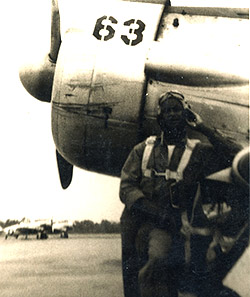World War II and the Home Front (1927-1954, Section 5)
1941
During World War II, more than 2.5 million black men and thousands of black women from across the country joined the military. Within the armed forces, they faced pervasive discrimination. Segregation practices often prevented many from serving in combat. The U.S. Congress finally forced the Army Air Corps to form an all-black combat unit.
In an effort to stifle the project before it began, the War Department set higher standards for admission to the unit, including flying experience and higher education, but it had failed to appreciate the complexity and achievements of the nation’s African Americans. Many qualified candidates applied and became part of the Tuskegee Airmen who flew with distinction in the European theater of the war. Among their numbers was Dr. Herman Aladdin Barnett III who soon played an important role in the history of black doctors in the Houston area.
Despite the nation’s victory over fascism and racism in Europe, many conditions in the segregated South had not changed. Dr. Robert Bacon was the son of domestic servants who worked in a wealthy Chicago suburb where he attended integrated public schools. After high school, he received an academic scholarship to Fisk University, a predominantly African-American school in Nashville, Tennessee. When he arrived in the southern city in 1941, Dr. Bacon found a university rich in tradition, but he also encountered Jim Crow segregation on a daily basis, something he had not known in Illinois. He recalls ending a date with a group of friends when he discovered that the theater only sold tickets to African Americans through a window in an alley and then required them to climb six flights of stairs to their segregated seats in the balcony. Dr. Bacon called it “a grand insult.” 1
Dr. Bacon chose to stay in school after the attack on Pearl Harbor. The U.S. Army had created the Army Specialized Training Program instituted at American universities to meet demands for junior officers and soldiers with technical skills. It also recruited outstanding pre-med students, such as Dr. Bacon, by offering to pay for medical school in exchange for future service when they graduated from medical school. Dr. Bacon received an early acceptance to Meharry Medical College in 1944.
Unfortunately, the Jim Crow segregation that Dr. Bacon encountered in Nashville continued across the South, although it differed from place to place. �After I had been here [Houston] for a while, I began to see the subtleties of segregation,� Dr. Bacon recalled in an interview. �In Mississippi, it was blunt trauma almost. But here, it was a rapier, fine-tuned� there was an undercurrent of fear in some areas.� 2 Houston remained the largest segregated city in the nation just as Houstonians prepared to launch an ambitious new project in health care.
Citations
- Dr. Robert Bacon, interview by Dr. Kathleen Brosnan, 28 March 2007, Houston, TX, tape recording.
- Ibid.


